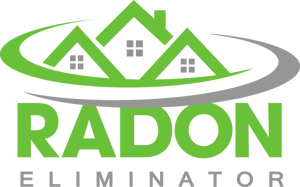There aren't enough people that have heard about radon.
And for the people who have heard about radon, not enough of them understand the implications of radon exposure.
That's why our team at Radon Eliminator has put together this FAQ.
We're hoping to answer your questions and educate the communities we serve in Ohio.
And in doing so, we hope we can protect their homes and the health of their families.
After reading these Radon FAQs, please don't hesitate to contact us if you still have questions about radon.
Table of Contents
- What Is Radon, and Where Does It Come From?
- What Is Radon Exposure And What Are The Signs?
- Why Is Radon Dangerous?
- Are There Any Other Health Risks?
- How Does Radon Get Into Your Home?
- What Is A Safe Level Of Radon?
- How Do You Test A Home For Radon?
- What Does A Professional Radon Contractor Do?
- Radon Eliminator
What Is Radon, and Where Does It Come From?
Radon is a colorless, odorless, and tasteless radioactive gas.
Radon forms by the decay of uranium in the soil.
When inhaled, the radioactive radon particles can damage the cells in the lining of your lungs.
Radon in water isn't as common or as dangerous. However, radon is most hazardous when it escapes the soil and gets into the air we breathe.
Radon gas often accumulates in low-lying areas like basements, and is present in many homes and workplaces, and exists undetected by the building's occupants.
For more information read our blog post: "What is Radon and Why is it Dangerous?"

What Is Radon Exposure And What Are The Signs?
Radon exposure occurs when you breathe in air with an elevated radon level over a long time.
Radon exposure over an extended period can cause long-lasting health problems like lung cancer and can be deadly.
Unfortunately, there's no way to know if you're being exposed to radon unless you perform radon testing.
Since exposure to radon causes lung cancer, the symptoms of radon exposure are similar to those of lung cancer.
They include:
- A persistent cough that doesn't get better
- Difficulty breathing
- Coughing up blood
- Chest pains
- Wheezing
- Hoarseness
Many people mistakenly dismiss these symptoms as a common cold, not knowing that the cause is something worse.
If you notice any of these symptoms, you need to consult a healthcare professional right away.
Why Is Radon Dangerous?
Radon is a cancerous gas with radioactive particles, and when breathed in, they get trapped in the lungs.
When enough of these radioactive particles build up in the lungs, severe lung issues can occur, like lung cancer.
The U.S. EPA estimates that more than 21,000 lung cancer deaths each year result from radon poisoning, second to only cigarette smoke, making it a serious health concern for all Americans.
Are There Any Other Health Risks?
Aside from lung cancer, are there any other health risks attributed to radon poisoning?And by then, it's too late because, by the time you notice these symptoms, you have likely developed lung cancer.
How Does Radon Get Into Your Home?
Radon forms in the ground, and it can move up through the dirt and rocks and into the air you breathe.
Radon can easily accumulate in indoor spaces, including your home, office, or school.
Radon typically enters your home through cracks in your foundation or walls.
However, radon can also enter your home through the following pathways:
- Uncapped hollow-block foundations
- Floor-wall joints
- Mortar joints
- Pores and cracks in concrete blocks
- Exposed soil (in a sump or crawl space)
- Loose-fitting pipe penetrations
- Building materials (brick, concrete, rock, etc.)
- Well water
Since your home will typically operate under negative air pressure, the air pressure inside your home is typically lower than the surrounding air and soil.
This pressure differentiation creates a vacuum that pulls soil gases into your home through these pathways.
Even if the ground under your home is frozen or soaked by rain, the gravel and soil underneath the house will still be warm and permeable, attracting radon gas from the surrounding soil.
Any time air enters a home from the underlying soil; radon can come along with it.

What is a Safe Level Of Radon?
The only safe level of radon is zero. If there is any radon in your home at all, it is a health hazard.The effects of radon may manifest even if your exposure occurs to smaller amounts of radon over a long period.
The danger of the gas lies in the concentration of radon in the environment.
If you perform radon testing and your results are above 4.0 pCi/L, you should consider a radon mitigation system and professional radon remediation services.
A radon mitigation system aims to reduce indoor radon levels as low as possible, at least below 2.0 pCi/L.
Depending on your location and several other factors, it may be possible to lower your levels below 2.0 pCi/L.
At Radon Eliminator, we strive to get your radon levels as low as possible.
How Do You Test A Home For Radon?
There are two standard methods to test your home for the presence of radon gas; short-term radon testing and long-term radon testing.
Short-term tests are designed for quick results and can be as short as 48 hours and as long as 90 days.
Long-term testing methods are more accurate and provide an annual average of radon gas.
Long-term tests use a continuous radon monitor for a minimum of 90 days.
They typically last from 6 to 12 months.
If you're in a pinch, like during a real estate sale, you can use a short-term test.
However, for the most accurate results, you should use a long-term test.
After any air sealing work, a radon specialist should also test heating/air conditioning system changes, or foundation modifications, your home again.
The results of your long-term test will determine your risk from radon and the necessity of radon mitigation.
What Does A Professional Radon Contractor Do?
Based on factors like your home's construction, the type of soil beneath your home, whether you have a finished basement or a crawlspace, and the climate in which you live, your radon contractor will design a radon mitigation system to lower your radon levels.
Your mitigation system will draw the radon gas beneath your home and vent it out above your roofline.
It should reduce your radon level to below 4.0 pCi/L, hopefully to 2.0 pCi/L.
The most commonly installed systems are active soil depressurization (ASD) systems.
Before installing your system, the contractor will inspect your home and seal all significant cracks, drains, sumps and crawlspaces.
The basic components of an ASD system are:
- Small holes called suction or draw points
- PVC pipe inserted into the holes and extended above the roofline
- A radon fan attached to the pipe
- A u-tube manometer attached to the pipe that monitors the operation of the fan
Radon Eliminator
The team at Radon Eliminator understands the risks of radon gas at elevated levels.
If you've never had your home tested for radon, there is no better time than now to get it tested.
You and your family could be breathing in elevated levels of radon without ever knowing it, and you could eventually develop lung cancer.
Radon Eliminator can test your home and install a radon mitigation system to lower your radon levels.
To take action and get started with Radon Eliminator, click the button below for a discounted test.





